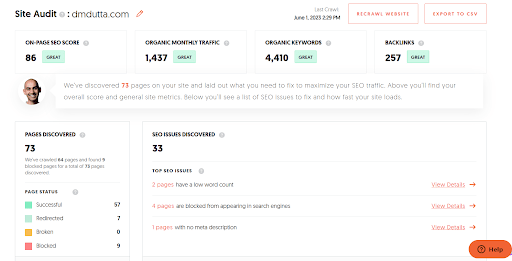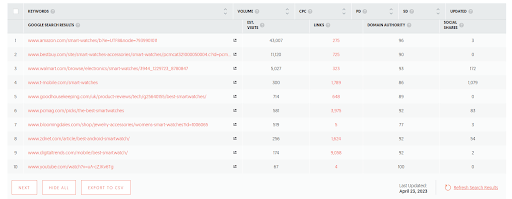How to Conduct a Content Audit for Your Business
A content audit can help inform a company’s content strategy. With the information they gleam, marketers can identify potential topics that will perform well in search and compete with their top competitors.
Before you can develop a robust content strategy to grow your business, you need to audit the content on your website. And not just for your own business website but for your competition too.
A content audit informs you all about the state of the industry and where your online presence stands compared to your competitors.
All in all, a content audit is an informative and enlightening activity to create enough clarity to help you move in the right direction.
In this post, I’ll share just how you can do a competitive content audit step-by-step.
Looking to improve your content and SEO efforts? Search for leading SEO companies on Top Design Firms.
Need help selecting a company?
Based on your budget, timeline, and specifications we can help you build a shortlist of companies that perfectly matches your project needs. Get started by submitting your project details.
What is a Content Audit?
A content audit is the process of gathering information about the content of your website and analyzing it to understand how its performing.
The process involves:
- Identifying content assets on your website, like your blog posts, videos, and more.
- Finding and cataloging your URLs
- Organizing your assets, URLs, and blog posts based on different categories
- Identifying top-ranking posts, keywords driving organic traffic, domain rating, and more
- Using Google Analytics and SEO tools to understand your performance.
There may be fewer or more steps depending on your needs. What matters is cataloging and understanding what your website is all about and whether it's engaging your audience.
A content audit can help surface areas where improvements can be made in quality and quantity. It can also uncover opportunities to make sure that your content is reaching its desired audience.

For example, if readers are not engaging with certain posts or articles as much as others, it could indicate that they need to be reworked or reframed.
It's also useful for identifying gaps in topics or angles you still have to explore. The content auditing process will help you identify and fill these gaps with unique content that will stand out from all the rest.
If you're auditing your competition (and you should), you'll learn which topics they rank for. You'll also determine if you should compete for the same topics or if you're better off working on something else.
In short, a content audit is an indispensable tool if you're going to develop a winning content strategy.
You'll ensure that your site is up-to-date, relevant, and compelling while keeping tabs on what’s working (and not working) for your competition so you can remain one step ahead.
How to Conduct a Competitive Content Audit
Auditing your website and your competitors' content can seem intimidating, but it doesn't have to be. You could hire an in-house specialist or an SEO agency or do it yourself.
Let's break down the steps to doing a competitive content audit.
- Start with an intention or goal
- Identify your assets
- Catalog and categorize your content
- Focus on key metrics
- Analyze your competitors
- Develop an action plan
- Execute and iterate ad needed
1. Start With an Intention or Goal
Any new project needs to begin with a goal in mind.
What's the purpose of creating a content audit in your business? Let's look at a few possible goals:
- You want to increase traffic organically
- You see a sudden decrease in traffic and engagement and want to know why
- You're going through a brand refresh and want to update all your assets
- You want to understand what topics or keywords your competition is ranking for so you can compete with them
Having a specific goal in mind will guide you throughout your content audit and help you make the most out of it.

Simple keyword research on UberSuggest helps identify top competitors for a keyword.
You'll know what metrics to track for yourself and the competition and where to improve.
2. Identify Your Assets With a Tool
Start by collecting all URLs associated with your company, such as blog posts, product pages, landing pages, and more.
To do this easily, you'll need an analytics and SEO tool to help. If you have a website with limited content, you can list your URLs manually, but you'll likely miss things like redirects, broken links, and so on.
This is why tools like Screaming Frog, Semrush, Ahrefs, and many others are useful platforms to subscribe to.
Note that if you have a sitemap, this will make it easy for you to find your URLs too.
3. Catalog and Categorize Your Content
Getting an overview of all the content on your site or your competitors' sites is a good start.
You should put all of the URLs you find in a spreadsheet to get an idea of the kind of content that exists.
Next, it's time to catalog and categorize your URLs based on different parameters.
For example, you should know what your oldest content assets are. Grouping your posts based on how long ago they were written or updated will let you know if you should refresh your content.
You could also group your URLs based on which stages of the buyer's journey they address. That is, which posts provide information during the awareness stage, which URLs or landing pages cater to the decision stage, and so on.
You can also group everything based on the content formats, topic clusters, best or worst performance, relevance, and more.
If you've defined your goals clearly, this step should be straightforward.
For example, if you want to know why your posts are not showing up in search results, you may find that many of them have not had an update in years.
Rewriting some posts and making minor updates to some others will help you improve your overall SEO score and boost traffic again.
4. Focus on Key Metrics
Aside from consolidating your URLs and content, you need to understand where the assets in your website are actually producing any results.
Your content audit should also give you a clear picture of your website's performance along different metrics.
Some things for you to look at are:
- A backlink report: Have backlinks to your website decreased or increased? Are there any links from bad sources that you should disavow? Which of your posts or assets get the most backlinks
- Domain rating or domain authority: These are terms developed by different SEO platforms to indicate how authoritative and healthy your website is. A higher Domain Rating indicates that your content is good quality and is SEO optimized. It also shows that you have a number of backlinks to your website, which indicates your trustworthiness.
- User engagement: Google Analytics will help you see how many users visited your website, how long they stayed on each page, and what kind of content they interacted with the most. This will give you a better understanding of your audience's needs and preferences.
- Social sharing: Learning which posts get the most shares on social media will help you understand which topics people are interested in and what kind of content resonates with them.
- Keywords: This is the most interesting and critical data you will get from your content audit. Knowing which keywords the competition is ranking for, as well as understanding what keywords are driving traffic to your website, will help you refine your content strategy.
Your content audit will start revealing your areas of strength and weaknesses by seeing where you stand based on the metrics showcased above.
5. Analyze Your Competitors
Now that you've gathered data about your site and your competitors, it's time to draw comparisons to learn how to improve.
For example, suppose your main competitor has a higher domain rating. In that case, this should push you to improve your own by cultivating backlinks through creating linkable assets and collaborations with other brands. This insight alone will help you build more meaningful content for your blog and through guest posts.
You can also find content gaps or topics that your competition hasn't covered that you can work on.
Or your competitors have better distribution since they're efficient at repurposing and resharing their content with multiple online channels.
Whatever you learn, you should get data-backed inspiration for ways to make your content strategy more effective.
6. Develop an Action Plan
Now it's time to use the data you've collected and the conclusions you've drawn to plan your next steps.
If you find that many of your posts are outdated, develop a schedule to refresh them. If you notice that some keywords perform better than others, create content around those topics to boost traffic.
You can also decide which content formats to focus on, where to share each post for maximum impact, and more.
Whatever you do, make sure that you link each problem area with a definite solution. And don't forget to celebrate your wins and learn from your success cases. If something is going well, you should know what it is and replicate it.
Ensure you document your top-performing material and have your marketing and content team understand how to leverage them. This will also help with content localization if you decide to go multilingual.
With the insights you've gained from your content audit, it'll be easier to create a plan that will help take your website or business to the next level.
7. Execute and Iterate
Finally, it's time to put everything into action.
At this stage, you should have a content calendar to keep track of your content production and distribution. You should also have a plan in place to measure the results of each piece you produce and an understanding of which channels are most effective for you.
Once everything is in motion, don't forget to review and adjust your strategy whenever necessary. Things change quickly on the web, so you must stay up-to-date. To do this, use social listening tools and a top-notch SEO platform.
It's time to trust the process and generate content to improve traffic, engagement, brand authority, and sales.
Let Content Auditing Boost Your Content Performance
A content audit is a powerful tool to help you understand your and your competitors’ website performance and optimize it for success. This process requires time and effort, but it's worth it as long as you know what metrics to measure and draw the right conclusions from them.
With the information gathered in your audit, you can effectively plan your next steps and keep iterating on your content. This post has covered all the key pieces of the content auditing puzzle.
Apply what you've learned today to start improving the performance of your website.
Additional Reading
Need help selecting a company?
Based on your budget, timeline, and specifications we can help you build a shortlist of companies that perfectly matches your project needs. Get started by submitting your project details.